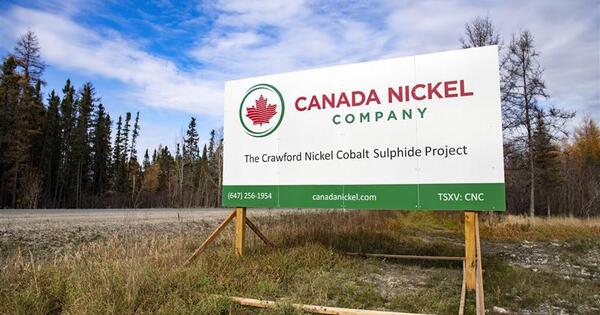Canada Nickel Company has released significant assay results from its Midlothian property, marking a promising development in Ontario’s emerging nickel district. The results revealed multiple wide intervals of nickel mineralization, reinforcing the company’s strategic position in what is rapidly becoming an important region for critical mineral exploration.
Located approximately 70 kilometers south of Timmins, Ontario, the Midlothian property represents part of Canada Nickel’s
...
Canada Nickel Company has released significant assay results from its Midlothian property, marking a promising development in Ontario’s emerging nickel district. The results revealed multiple wide intervals of nickel mineralization, reinforcing the company’s strategic position in what is rapidly becoming an important region for critical mineral exploration.
Located approximately 70 kilometers south of Timmins, Ontario, the Midlothian property represents part of Canada Nickel’s regional land package that spans over 42 kilometers of prospective targets within the same geological structure as its flagship Crawford project.
Mark Selby, CEO of Canada Nickel, expressed enthusiasm about the findings. “These initial results from Midlothian are very encouraging and confirm our thesis that multiple targets across our regional land package have the potential to host large-scale, low-grade nickel deposits similar to our Crawford project,” Selby stated.
The drilling program at Midlothian consisted of nine holes totaling 4,182 meters, with assay results now available for five of these holes. The most notable results came from hole MID23-01, which returned 0.25% nickel over 157 meters, including a higher-grade section of 0.30% nickel over 34.5 meters. Another significant intersection in hole MID23-02 yielded 0.24% nickel over 131 meters.
These findings are particularly noteworthy as they mirror the mineralization profile seen at Crawford, which has become one of the world’s largest undeveloped nickel sulfide resources. The company noted that Midlothian’s potential extends beyond what has been drilled thus far, with geophysical anomalies suggesting the mineralized zone could stretch across a three-kilometer strike length.
The Midlothian property’s geological characteristics show strong similarities to the Crawford deposit, featuring ultramafic rock sequences with dunite and peridotite compositions. These rock types are known for hosting nickel mineralization in the form of pentlandite, heazlewoodite, and awaruite – minerals that are typically associated with large-scale nickel deposits.
Industry analysts point out that these results come at a crucial time for the nickel market, which has seen increasing demand driven by the electric vehicle battery sector. Nickel is a critical component in high-energy-density batteries, and securing domestic supply chains has become a priority for North American manufacturers.
“The development of new nickel resources in politically stable jurisdictions like Canada has taken on greater significance in recent years,” explained mining sector analyst Sarah Johnson. “As automakers continue to increase their electric vehicle production targets, the pressure to find reliable nickel sources outside of traditional suppliers like Indonesia and Russia has intensified.”
Canada Nickel’s exploration success at Midlothian also highlights the growing importance of Ontario’s mining sector in the global critical minerals landscape. The province has been actively promoting its mining potential through initiatives like the Critical Minerals Strategy, which aims to position Ontario as a leading supplier of minerals essential for the clean energy transition.
The Timmins region, already famous for its gold mining history, is now emerging as a significant nickel district. This transformation aligns with broader trends in the mining industry, where traditional mining regions are being reevaluated for their potential to host minerals crucial for modern technologies.
From an environmental perspective, Canada Nickel has emphasized its commitment to developing low-carbon nickel production. The company’s approach includes the potential use of serpentine rock, which naturally absorbs CO2 when exposed to air, potentially allowing for carbon-neutral or even carbon-negative mining operations.
Investors have taken notice of these developments, with Canada Nickel’s share price responding positively to the announcement. The company’s focus on both exploration success and sustainable mining practices has attracted attention from ESG-conscious investors looking for responsible exposure to the battery metals sector.
Looking ahead, Canada Nickel plans to continue its regional exploration program across its extensive land package. The company has indicated that additional assay results from the remaining four holes at Midlothian are expected in the coming weeks, which could further define the property’s potential.
The success at Midlothian adds to Canada Nickel’s growing portfolio of nickel assets in the region, including the Reid, Deloro, and Sothman properties, all of which share geological similarities with Crawford. This cluster of properties positions the company to potentially develop a nickel mining hub in Ontario, contributing to North America’s push for critical mineral security.
As global demand for nickel continues to grow, particularly from electric vehicle manufacturers and energy storage systems, discoveries like those at Midlothian will play an increasingly important role in reshaping the international nickel supply chain.


